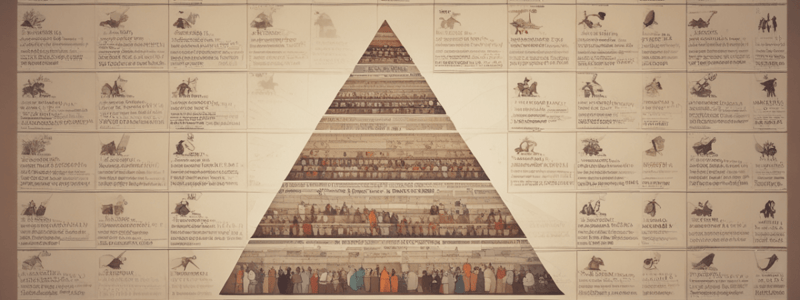Podcast
Questions and Answers
What is the main characteristic of a population pyramid in Stage 1 of the Demographic Transition model?
What is the main characteristic of a population pyramid in Stage 1 of the Demographic Transition model?
- Expansive (correct)
- Constrictive
- Linear
- Stationary
In which stage of the Demographic Transition model do women tend to marry and have children later, leading to a decrease in birth rate?
In which stage of the Demographic Transition model do women tend to marry and have children later, leading to a decrease in birth rate?
- Stage 1
- Stage 4
- Stage 3 (correct)
- Stage 2
What is the term used to describe the period when the share of the working-age population is larger than the non-working-age population?
What is the term used to describe the period when the share of the working-age population is larger than the non-working-age population?
- Demographic dividend (correct)
- Old-age dependency ratio
- Population growth
- Youth dependency ratio
What is the main characteristic of a population pyramid in developed countries (Stages 4 and 5) of the Demographic Transition model?
What is the main characteristic of a population pyramid in developed countries (Stages 4 and 5) of the Demographic Transition model?
What is the primary reason for the high mortality rate in Stage 1 of the Demographic Transition model?
What is the primary reason for the high mortality rate in Stage 1 of the Demographic Transition model?
What is the main difference between Stage 2 and Stage 3 of the Demographic Transition model?
What is the main difference between Stage 2 and Stage 3 of the Demographic Transition model?
What is the characteristic of population growth in Stage 2 of the Demographic Transition model?
What is the characteristic of population growth in Stage 2 of the Demographic Transition model?
What is the term used to describe the ratio of elderly people to working-age people in a population?
What is the term used to describe the ratio of elderly people to working-age people in a population?
What is the main characteristic of a population pyramid in Stage 3 of the Demographic Transition model?
What is the main characteristic of a population pyramid in Stage 3 of the Demographic Transition model?
What is the primary reason for the low birth rate in developed countries (Stages 4 and 5) of the Demographic Transition model?
What is the primary reason for the low birth rate in developed countries (Stages 4 and 5) of the Demographic Transition model?
What is the primary focus of demography?
What is the primary focus of demography?
What is the main purpose of a population pyramid?
What is the main purpose of a population pyramid?
What is the definition of total dependency ratios?
What is the definition of total dependency ratios?
What is the typical age range for the youth population?
What is the typical age range for the youth population?
What is the typical age range for the elderly population?
What is the typical age range for the elderly population?
What is the characteristic of an expansive population pyramid?
What is the characteristic of an expansive population pyramid?
What contributes to high total dependency ratios?
What contributes to high total dependency ratios?
What is the shape of a stationary population pyramid?
What is the shape of a stationary population pyramid?
What is the result of low birth rates and low death rates in a population pyramid?
What is the result of low birth rates and low death rates in a population pyramid?
What is the main difference between an expansive population pyramid and a stationary population pyramid?
What is the main difference between an expansive population pyramid and a stationary population pyramid?
Flashcards are hidden until you start studying
Study Notes
Demography
- Scientific study of human populations, focusing on size, structure, and distribution
- Analyzes data on births, deaths, migration, and aging, and how these factors influence population changes over time
Population Pyramid
- Graph that shows the distribution of ages across a population of an area
- Used to estimate future trends in birth rates, death rates, and Total Dependency Ratios
- Three types:
- Expansive (sharp triangle shape): high birth rate and high death rate, resulting in high Total Dependency Ratios
- Stationary (rectangle or "pillar" shape): low birth rate and low death rate, resulting in moderate Total Dependency Ratios
- Constrictive (upside-down triangle): low birth rate and moderate death rate, resulting in high Total Dependency Ratios
Total Dependency Ratios
- Measure that compares the proportion of the population that is not in the labor force (dependents) to the proportion of the population that is in the labor force (productive workers)
- Youth Dependency: high youth dependency ratio occurs when the number of people below the working age population is higher than the ageing population
- Old-Age Dependency: high old-age dependency ratio occurs when there are high numbers of middle-aged and elderly people, but fewer young people
Demographic Transition
- Model that describes the transformation of a population from high birth and death rates to low birth and death rates over time
- Five stages:
- Stage 1: Early agricultural society, high birth rate and death rate, stable and slowly increasing population growth, expansive population pyramid
- Stage 2: Developing countries, high birth rate, falling death rate, rapidly increasing population growth, expansive population pyramid
- Stage 3: Developing countries, falling birth rate, falling death rate, increasing population growth, demographic dividend, stationary population pyramid
- Stages 4 and 5: Developed countries, low birth rate, low death rate, falling and then stable population growth, high old-age dependency ratio, stationary to constrictive population pyramid
Studying That Suits You
Use AI to generate personalized quizzes and flashcards to suit your learning preferences.



